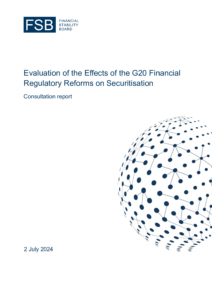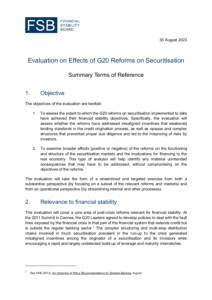Summary of document history
A range of regulatory reforms were introduced to the securitisation markets to address the misalignment of incentives which occurred in certain securitisation structures in the run up to the 2008 global financial crisis.
The complex structuring and multi-step distribution chains involved in certain securitisation structures in the run-up to the 2008 global financial crisis generated misaligned incentives between the originator of a securitisation and its investors and led to weakened lending standards, while amplifying a rapid and largely undetected build-up of leverage and maturity mismatches.
A number of regulatory reforms have since been introduced to improve transparency, address conflicts of interest, strengthen the regulatory capital treatment for banks’ securitisation exposures by improving risk sensitivity and reducing cliff effects, and align incentives associated with securitisation.
This evaluation report focuses, in terms of scope, on the collateralised debt/loan obligation (CDO/CLO) and the nongovernment-guaranteed part of the residential mortgage-backed securities (RMBS) markets; and, in terms of reforms, on the International Organization of Securities Commissions (IOSCO) minimum retention recommendations to address incentive problems and the Basel Committee on Banking Supervision (BCBS) revisions to prudential requirements for banks’ securitisation-related exposures. These reforms aimed to address the vulnerabilities in the securitisation market that contributed to the amplification of losses during the 2008 global financial crisis.
The report provides an overview of securitisation markets across FSB member jurisdictions and outlines the securitisation reforms and their implementation status.
The analysis carried out by the evaluation suggests that the BCBS and IOSCO reforms have contributed to the resilience of the securitisation market without strong evidence of material negative side-effects on financing to the economy. However, the post-GFC securitisation market has not yet been tested through a full credit cycle to fully confirm the evidence on enhanced resilience. This is particularly relevant for CLOs that have grown significantly in recent years but have not, as yet, experienced a prolonged downturn.
Consistent with the FSB’s evaluation framework, the evaluation does not make policy recommendations but identifies some issues for consideration by relevant national authorities and international bodies related to:
- Monitoring risks from recent developments in securitisation markets
- The role of risk retention in the global CLO market
- Third-party risk financing for CLOs
- Implementation of securitisation reforms

